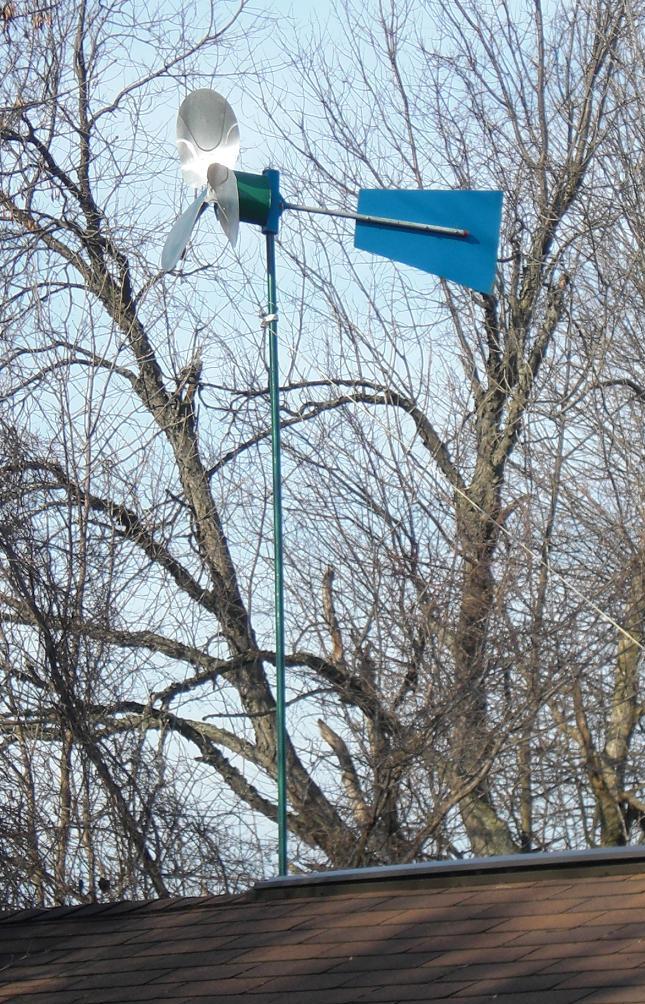|



|
Older homes can significantly reduce their consumption of energy and their emission of carbon, as a key step towards addressing the energy & environmental challenges facing Canada. (this task is easy for new homes, but that's another story)
This 3,700 ft2 home was built in 1984 with south-facing orientation and double-wall construction. In 2006, it upgraded insulation levels and implemented basic measures including insulation of basement headers and swapping to low-flow toilets, converting to LED lights (no toxic hazard of CFL, lower cost to operate, better selection of colour spectrum, facilitates 12V DC from solar panels or wind turbines), adding set-back timers & motion sensors, sealing walls against air leakage, installing destratification fans, adding rain barrels, planting dozens of trees, covering ashpalt shingles with an Energy Star metal roof (decreases cooling demand, increases efficiency of roof-mounted solar PV panels) and upgrading to Energy Star for all appliances & windows (final section of windws are triple-pane glass with double low-E coating, filled with Krypton gas).
It installed a heat recovery ventilator and replaced the propane furnace with a ground source heat pump with horizontal loop so it qualifies as a NetZeroPlus building (energy produced by the building exceeds energy consumed by the building).
The interior was refurbished in compliance with LEED guidelines (Canada had not yet adopted the standard for residential retrofits) by recycling most original building materials and installing FSC-certified teak hardwood flooring, among many other actions. The major eco-sin was to import granite from Brazil for the kitchen countertops.
The renovations boosted the EnerGuide for Houses efficiency rating to 90, which makes it one of the top energy-efficient private retrofits in Canada despite its more than quarter-century age. An ATIP request showed that 17 homes have been rated higher, but the age of those houses is unknown.
For the 14.3 million households in Canada, each square foot of floorspace consumes 18.5 kWh every year for space heating, water heating, appliances, lights & space cooling (total combined electric AND thermal) according to 2016 federal energy data. In that year, this renovated green home consumed 16,300 kWh or 4.4 kWh per ft2 per year ... 75% lower than national average. The NetZeroPlus heat pump supplies total thermal load from renewable energy on a dispatchable basis, so 90% of all power is consumed outside of peak TOU period which benefits the local distribution utility in terms of load levelling.
For GHG, these 14.3 million households have total floorspace of 2,029 million m2 and emit 61.1 megatonne of carbon each year, so the average emission per dwelling is 4.3 tonne (4,270 kg). At 3,700 ft2, this green home should emit more than 10 tonne for all energy, but it emits 400 kg ... 96% lower than the national average because it uses propane for cooking and for emergency space heating.
Not only does my-green-home show that it IS possible to take personal action that makes a real difference in the climate fight, but energy expenses decline dramatically (especially if peak TOU periods are avoided), the home is ready for an ice storm or grid blackout, it increases occupant comfort & safety, and it increases equity in future housing stock.
It can get older ... and get better.
As part of our commitment to sustainability, this was the first home in eastern Ontario to mount 10 kW of rooftop solar panels under Ontario's feed-in tariff. The annual output of 9,000 kWh is not counted towards the home's NetZeroPlus status (panels will not generate during a power failure and all output is sold to the provincial grid) but the metal roof increases the efficiency slightly, another demonstration of how a holistic integration can benefit individuals and society.
|
To put our investment in context:
In 2005, the average EGH (EnerGuide for Housing) rating for all Canadian homes that had been assessed (a self-selecting universe of energy-conscious homeowners) was 66. Of homes built in the 1980s, the average 'start' rating (before renovations) was 65, and 72 for the 'finish' rating (after all upgrades are complete). To qualify as R-2000, a new house must be EGH 80. NRCan reports that, as of 2012, 17 houses in Canada scored above EGH 90.
On the international scene, a EuroBarometer survey (2009) of 27,000 citizens in Europe found that 78% of respondants separate waste for recycling and 41% avoid plastic bags. “Greener energy options are the least popular, with only 9% switching to a greener energy tariff or supplier, and only 6% having installed their own energy generation equipment" such as solar panels or wind turbines, the report notes. When asked about greener forms of energy, 25% were willing to pay 1-5% more, 20% would pay 6-20% more, and 4% were willing to pay a premium of 20%, but 27% were unwilling to pay any extra for renewable energy. Europeans have a reputation for being more energy-conscious than Canadians, and behaviour surveys skew to the positive (eg: respondants say they recycle even if they have done so only once). This makes a large after-tax investment in low-carbon options to be quite significant.
|
Bill Eggertson has been involved in the renewable energy sector since 1985, managing the canadian association for renewable energies, the Canadian chapter of the International Ground Source Heat Pump Association, the Earth Energy Society of Canada, the Solar Energy Society of Canada, as well as contract positions with the Canadian Solar Industries Association and the Canadian Wind Energy Association, among others. He was senior editor for major renewable energy publications in the UK (RenewableEnergyFocus) and in the US (SolarAccess.com). He was programme manager for the UK government's climate security program in Canada, and was trained by Al Gore under The Climate Reality initiative to explain the implications of anthropogenic emissions of greenhouse gases. His strong commitment to the environment was the reason for his selection as a torchbearer in the 2010 Olympic relay.
|
|

![]()
